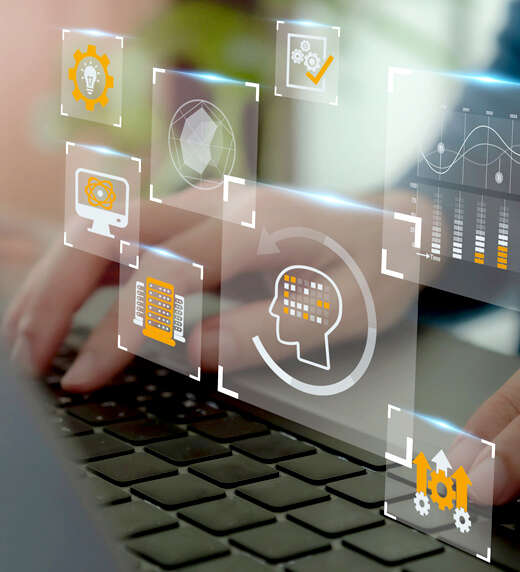
Authors’ note: In the spirit of human-machine and AI collaboration, this article was written as a joint effort between ourselves and the AI tool ChatGPT. Though we recommend proceeding with caution when leveraging AI throughout your organization, it is a real-life example of how AI and human-machine collaboration can be productively utilized in the workforce.
Artificial intelligence (AI) is rapidly advancing and has the potential to revolutionize the way we live and work. However, there are concerns that AI could replace human workers, leading to job displacement and unemployment. It's important to remember that AI is not necessarily a replacement for humans (although certain tasks could very easily be done by AI alone). Rather, AI is a tool that can be used to augment and enhance human work.
In this article, we will explore the importance of human-machine collaboration and the potential benefits it can bring to your workforce.
History provides a wealth of examples of how workers’ roles evolve along with technology.
For instance, for the first 100 years of its existence, bowling was an incredibly simple game. A person employed as a pin setter would pick up all the pins by hand and put them back in place. Every. Single. Frame. Thankfully for the setters (who were at risk of an errant ball coming their way), by the 1950s, we had widespread adoption of automatic pin setting machines. Bowling alleys boomed and created even more jobs as they became increasingly popular, but the needs of businesses and roles of workers evolved.
Similarly, while ATMs are ubiquitous now, that wasn’t always the case. The introduction of ATMs streamlined the process of withdrawing cash and conducting basic banking transactions, and it also increased the volume of banking activity overall. This heightened demand necessitated the hiring of additional bank tellers to manage more complex transactions and handle customer inquiries that cannot be addressed through an ATM. The number of bank tellers doubled from 1970 to 2010.
The implementation of ATMs also enabled banks to expand their reach and serve customers in more remote locations without the need for as many personnel in a physical branch. This reduced the cost per branch, allowing an explosion of new branches and greater convenience for the end consumer.
Bill Gates wrote, “The development of AI is as fundamental as the creation of the microprocessor, the personal computer, the Internet, and the mobile phone. It will change the way people work, learn, travel, get health care, and communicate with each other. Entire industries will reorient around it. Businesses will distinguish themselves by how well they use it.” Clearly AI is here to stay, and as Gates hints at, effectively partnering with AI as the next phase of human-machine collaboration could very soon make or break your business, or even entire industries.
A partnership between humans and AI systems leverages the strengths of each to achieve better outcomes. AI systems are designed to process vast amounts of data quickly and accurately, while humans are skilled at tasks that require creativity, intuition and emotional intelligence. By combining the strengths of both, human-machine collaboration can lead to better decision-making, increased productivity and improved outcomes.
One of the most significant benefits of human-machine collaboration is the ability to automate tedious and repetitive tasks, freeing up human workers to focus on more complex and creative work. AI systems can perform tasks such as data entry, analysis and categorization much faster and more accurately than humans. By automating these tasks, humans can spend more time on work that requires their unique skills and expertise.
While AI systems can perform many tasks more quickly and accurately than humans, they lack the ability to understand the nuances of human behavior and emotions. Humans are better equipped to interpret social cues, understand context and make judgments based on ethical and moral considerations. In situations where human input is essential, AI systems can be programmed to provide recommendations based on the data they have processed, but the final decision rests with the human worker.
In a Harvard Business Review article, authors Joe McKendrick and Andy Thurai said, “We still need humans in the middle to assess the value of insights and decisions to the welfare of humans, businesses and communities. AI can help with providing decision-making points, but humans must still be involved in making that decision — ultimately, it needs to be augmented intelligence instead of pure artificial intelligence.”
As AI technology continues to evolve, it’s natural to be amazed that these machines can “think” just like us. We are captivated by what is created not only because of the new capabilities it brings but also because it is shaped within a context that we comprehend. Since humans are still an integral part in the training of these models, it is crucial to remember that we still ultimately decide what’s important and how a model should act. AI may be clever at solving a problem, but it’s still typically solving a problem that a person defined.
Too often, AI evokes images of a sentient being, which in turn leads to imagining replacing people with machines (Skynet, anyone?). A more apt comparison is that of using tools. Using Google or Excel in a business setting is commonplace now and occurs without a second thought.
Open up ChatGPT or the latest AI tool today, and until you enter a command, nothing will happen on its own. Much like the pin setter and ATM example from before, we’re still bowling and banking, just making our lives easier as we do it.
Human-machine collaboration and AI have the potential to revolutionize the way we work and can bring numerous business benefits, including:
The natural reaction is to think of the largest changes AI could make first, such as displacing workers, but it tends to be the mundane work tasks where you see the more immediate benefit.
For example, a company may automate approval processes to quickly turn around contracts and collect signatures. Or it may leverage robotic process automation (RPA) to automate data extraction from different statements, allowing for quickly consolidated information without burdening an employee to copy/paste values for hours. The benefit isn’t the 40 hours a week saved by replacing a job, but rather the 10 hours a month that employees gain to focus their abilities on what’s most important.
As AI systems become more advanced and prevalent, the role of human workers will continue to evolve. However, it's important to remember that AI is not a replacement for humans, but rather a tool that can be used to augment and enhance human work. Ethical quandaries and nuance are still largely human tasks and will likely remain that way for the foreseeable future. The future of work will be characterized by human-machine collaboration, where humans and AI systems work together to achieve better outcomes.
If we recognize that AI is a piece of a puzzle as opposed to the final solution, it’s more clear that an AI tool can quickly improve the quality of life for the average worker. No one wants their job replaced, but plenty of people will raise their hands if you ask what tasks they’d rather have off their plates.
The rapid advancement of AI technology has brought about remarkable changes in the way we work, communicate and interact with the world. As AI systems continue to evolve and enable the digital transformation that so many companies are undergoing, the importance of human-machine collaboration will only become more critical.
Like any new technology, training is crucial to achieving a desired result. Organizations seeking to benefit from advances in AI must enable their employees with the right technologies and training, and empower their business to embrace a culture of innovation and experimentation. Ultimately, the successful adoption of AI technology requires a thoughtful and collaborative approach, with humans and machines working together toward a common goal.
If you’d like to explore ways to implement an AI program at your organization, contact the AI experts of Armanino Intelligence. You can also check out our video series From Hype to Reality: How AI is Reshaping the Future of Work.


